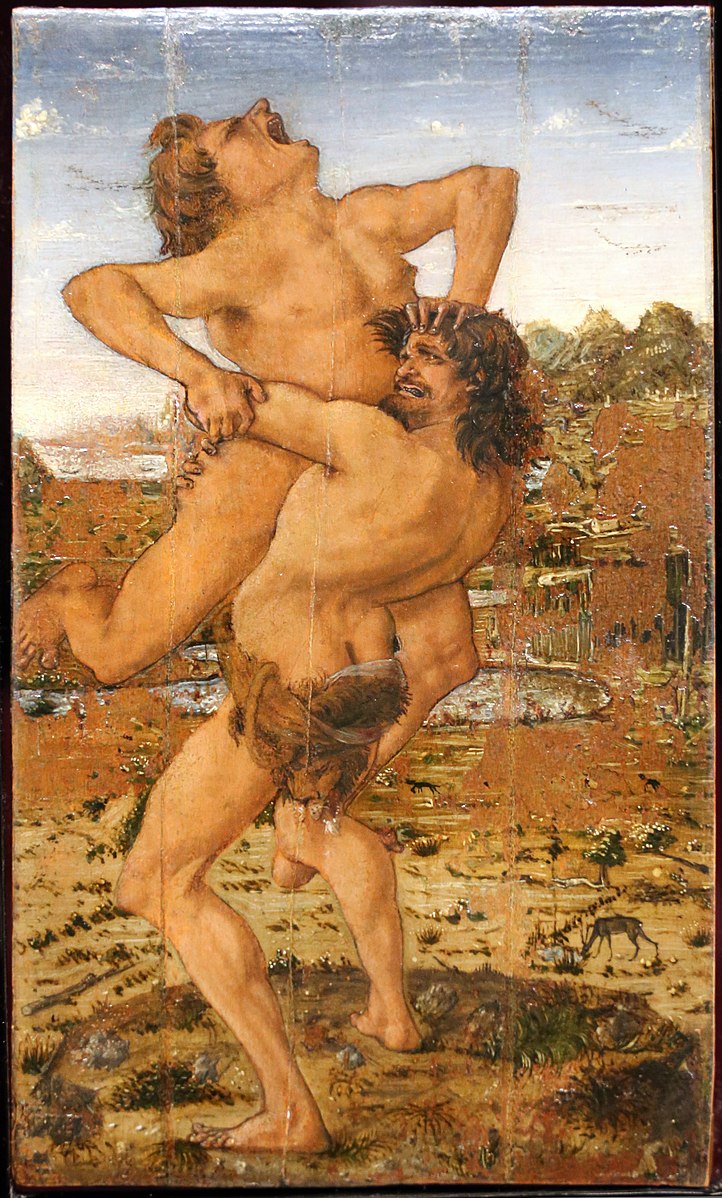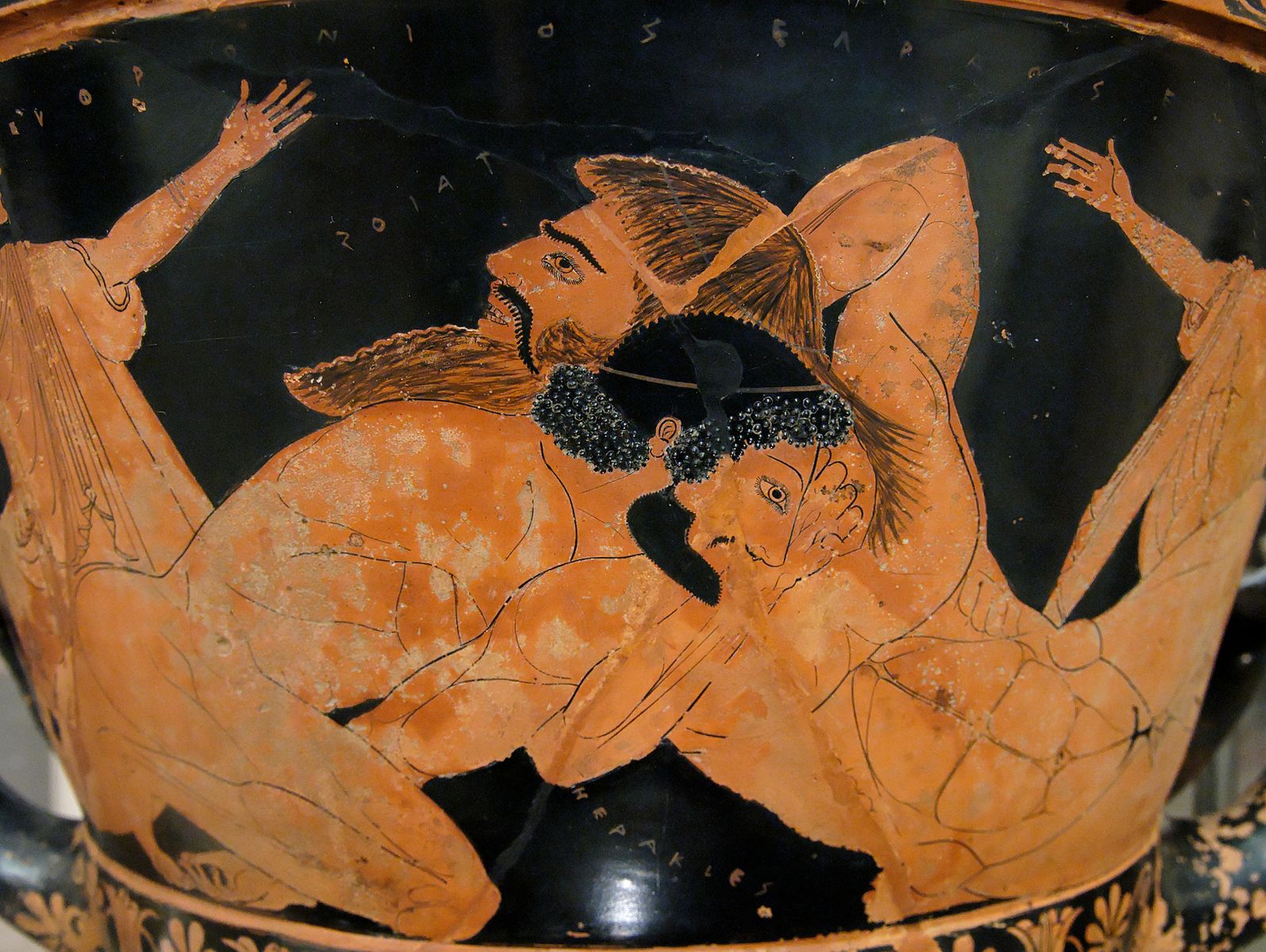2022.06.27 | By Gregory Nagy
§0. As I started to argue in Essay 1, the name of Mount Olympus as the setting for a myth about the immortalization of the hero Hēraklēs after death—his apotheosis—is linked with the name of Olympia as a setting for myths about the founding of the Olympics by this hero. In Essay 2 here, I take the argument further: the various different versions of myths about the founding of the Olympics by Hēraklēs reveal a Mycenaean background for the figuring of this hero as a model for athletes competing at the Olympics in particular and at any other athletic festival in general. I say “a Mycenaean background” and not “Mycenaean origins” for reasons I will explain in what follows. These reasons, as we will see, have to do with methodologies I use in my various efforts to reconstruct the past. As for the actual argument I am about to offer, the image I have chosen to introduce this essay is directly relevant. What we see here is the picturing, by a Renaissance artist, of a celebrated ancient myth that told about a primordial athletic event: it was a wrestling match between Hēraklēs and a homicidal ogre named Antaios, who was figured as an enemy of the civilized world.

Antonio del Pollaiuolo (1429–1498), Hercules and Antaeus. Florence, Galleria degli Uffizi, inv. no. 1478. Image via Wikimedia Commons.

§1. A most lively introduction to this myth about a primal wrestling match between Hēraklēs and Antaios is available in the “Universal History” composed by Diodorus of Sicily, who as we have seen lived in the first century BCE. As we read in Diodorus (4.17.4; further details at 4.27.3), Hēraklēs in his role as promoter of the civilized world travels to Libya, where Greek visitors to this land are being systematically killed off by Antaios, an ogre who forces any incoming visitor to compete with him in a wrestling match that he always wins—and the result is always death for the unfortunate visitor. In the wording of Diodorus here, such a visitor is a xenos, that is, a potential ‘guest-friend’ who is entitled to guest-friendship in terms of the customary laws of Greek-speaking people. But the supremacy of Antaios as a world-class wrestler is ended by Hēraklēs: the hero challenges Antaios to a wrestling match that he of course wins. By winning, Hēraklēs actually kills the ogre, thus making Libya safe for civilization—or, to put it in terms of the “universal history” composed by Diodorus, Hēraklēs makes Libya safe for inhabitation by Greek-speaking people. In the era of Diodorus, after all, Libya was the region of North Africa dominated by the Greek city of Cyrene, which was world-renowned for its wealth and its cultural prestige. And the narrative of Diodorus here (again, 4.17.4) describes in cultural terms the flourishing of Libya after the defeat of Antaios by Hēraklēs, this universal culture hero. Such a pattern of story-telling is then immediately repeated by Diodorus (4.18.1; further details at 4.27.3) as he now proceeds to narrate the very next adventure of Hēraklēs: the hero now travels from Libya, further West in North Africa, to neighboring Egypt, further East, where he kills the ogre-king Bousiris, another serial killer of incoming “visitors.” Thus Hēraklēs has now made Egypt safe for Greek-speaking people. In the historical era of Diodorus, of course, Hellenized Egypt surpassed even Hellenized Libya in wealth and cultural prestige
§2. Details of the myth about the defeat of Antaios by Hēraklēs are recounted in the narrative of “Apollodorus” in his Library, dated to the sceond century CE. As we read in “Apollodorus” (2.115), Antaios was the son of Gaia, Mother Earth, and his successes as a world-class wrestler were due to his groundedness, as it were, on Earth: that is why Hēraklēs during his primal wrestling match with Antaios could kill the ogre only if he lifted him in the air and thus got him off the ground. It is this fatal moment, when Antaios loses his grounding, that we see captured in the picture that I show to illustrate the myth.
§3. Even the name Antaios is relevant to the myth about the wrestling match of Antaios with Hēraklēs: the second part of this compound noun Ant-aios is evidently derived from the noun aia, which means ‘earth’, while the first part, the prefix anti-, can be understood in the sense of ‘competing with, substituting for, matching’. Antaios, son of Mother Earth, is a most worthy matching counterpart of his mother’s powers.
§4. But why do I think that the myth about Hēraklēs as a world-class wrestler, reported in the “universal history” of Diodorus, can be used as evidence to support my argument that there is a Mycenaean background for Hēraklēs as a model for athletes? Here I turn to another myth, reported by Diodorus (4.14.1–2), who says that one of the greatest of all the achievements of Hēraklēs was his founding of the Olympics, that is, of the Olympic festival at Olympia. Further, as Diodorus also says (4.14.2), Hēraklēs not only founded this major festival: he also competed and won in every athletic event on the prototypical occasion of the first Olympics ever celebrated. Just as in the later narrative of Diodorus (4.17.4) about the prototypical athletic victory of Hēraklēs in his wrestling match with Antaios, this previous narrative of his (again, 4.14.1–2) glorifies Hēraklēs as a culture hero who builds the very foundations of Greek civilization. In Essay 1, we have already seen a comparable narrative, where I cited references in the songs of Pindar, dating from the first half of the fifth century BCE, to the founding of the Olympics by Hēraklēs.
§5. In the era of Diodorus, the myths about Hēraklēs as a model for athletes could be interpreted as a sign of this hero’s Panhellenic status as a universal champion of Greek civilization. But even back in the era of the Mycenaean empire, well over a thousand years earlier, back in a distant time when the universalizing cultural phenomenon that we can describe retrospectively as Panhellenism had not yet taken shape, I argue that there had already existed comparable myths, though in this case the status of Hēraklēs as a hero was not yet universalized by the various populations of the Greek-speaking world back then.
§6. The idea of a non-universalized Hēraklēs in the Mycenaean era is comparable, I think, to the idea of a non-universalized Mount Olympus in the same distant past. As I noted in Essay 1, the existence of such a fragmented idea of Olympus in the Mycenaean era, when many different mountains in many different places were known by that name as the abode of the gods, was argued by Martin P. Nilsson in Chapter 4 (pages 221–251) of The Mycenaean Origins of Greek Mythology (1932). And now I add that Nilsson also argued, in Chapter 3 of the same book (pages 187–220), that there also existed a comparably fragmented idea of a proto-Hēraklēs in the Mycenaean era. As Nilsson pointed out, there were many different versions of such a hero throughout the Greek-speaking world—and such a hero was not even always known by the same name.
§7. In Essay 1, I already argued that there had existed a Mycenaean background for the naming of Olympia, parallel to the Mycenaean background, as posited by Nilsson, for the naming of Olympus. But now I argue, by extension, that there also existed a Mycenaean background for linking the actual site of Olympia with myths about Hēraklēs as a founder of athletic competitions at this site. The methodology I use for making such an argument is comparative, in that I analyze the myths and rituals involving the names of Olympus and Olympia by way of critically comparing historical contexts where the hero known as Hēraklēs is linked with both places so named, that is with both Olympus and Olympia.
§8. Such a methodology would have been too broad for Nilsson, whose own method was more restrictive. For him, only the evidence from archaeology could be brought to bear: if he found no evidence for Mycenaean remains at a given site, then the myths that were linked with such a site could not possibly be traced back to Mycenaean “origins.” So, my linking of Olympia with Hēraklēs would have been for Nilsson untenable if there had existed no Mycenaean archaeological remains of any significance to be found at Olympia. And that was in fact exactly the state of affairs at the time when Nilsson’s Mycenaean Origins was published: as Nilsson pointed out in his book (1932:90), Olympia yielded practically no evidence at the time of his writing. So, Nilsson effectively gave up on Olympia (1932:236; also 90–92). But things changed. By the time of Emily Vermeule’s introduction to Nilsson’s book, 40 years later, a wealth of new archaeological evidence for Mycenaean remains at Olympia had already come to light: as she notes, by now “Olympia has been drawn firmly within the Mycenaean realm” (Vermeule 1972:xii).
§9. Accordingly, in what follows, I will be arguing that the various versions of myths concerning a “proto-Hēraklēs” in the Mycenaean era can be linked with the site of Olympia as a place where such a hero became a model for athletic competition.
Bibliography
Nilsson, M. P. 1972. The Mycenaean Origins of Greek Mythology. Sather Classical Lectures 8. Paperback edition, with new introduction and bibliography by E. Vermeule. Berkeley. Original publication 1932.
Vermeule E. 1972. New introduction and bibliography for Nilsson 1972:vii–xv.